Ashraful Islam, Arun Kanti Guha
Department of Textile Engineering, Southeast University, Banani, Dhaka 1213
Correspondence to: Arun Kanti Guha, Department of Textile Engineering, Southeast University, Banani, Dhaka 1213.
| Email: |  |
Copyright © 2012 Scientific & Academic Publishing. All Rights Reserved.
Abstract
The pH of Textile effluent is generally high because of use of many alkaline substances in Textile processing. The total dissolved solids (TDS) are those solids remain as soluble form in Textile effluent. There are several methods available for removal of TDS and color from Textile effluent such as, ion exchange, coagulation and flocculation, biological decolorization, adsorption etc. Among all these methods adsorption is still a procedure of choice for TDS and color removal. Several naturally occurring aquatic/non aquatic plants have been used in this work as adsorbents. These were water hyacinth, water lily and bark of plantain plant (banana). All of three plants could be useful for adsorption of pollutants but considering all experimental results the remarkable result was achieved in case of adsorption of pollutants on plantain plant (banana) bark from inlet effluent of Echotex Ltd; Chandra, Gazipur, Bangladesh. Both the pH and TDS removal obtained in this case, pH values were 7.3 (before treatment) and 6.5 (after treatment) and TDS values were 2700 mg/L (before treatment) and 2600 mg/L (after treatment). Different combinations of coagulants were also used for color removal and sludge separation. The best color removal and sludge separation were obtained in case of FeSO4 + CaO.
Keywords:
pH, Color, TDS, Removal, Textile Effluent, Coagulation, Adsorption
Cite this paper: Ashraful Islam, Arun Kanti Guha, Removal of pH, TDS and Color from Textile Effluent by Using Coagulants and Aquatic/Non Aquatic Plants as Adsorbents, Resources and Environment, Vol. 3 No. 5, 2013, pp. 101-114. doi: 10.5923/j.re.20130305.01.
1. Introduction
Considering both volume and composition, the wastewater produced by the textile industry is the most polluting among all industrial sectors[1]. Effluent from the textile industry commonly contains high concentrations of organic and inorganic chemicals and are characterized by high Chemical Oxygen Demand (COD), Biological Oxygen Demand (BOD), Total Dissolved Solids (TDS), pH, Total Suspended Solids (TSS) values and low Dissolved Oxygen (DO) value as well as strong color. The major concern with color is its aesthetic character at the point of discharge with respect to the visibility of the receiving waters[2]. In the near future, most European countries will issue stricter standards on colored waste streams. It is likely that Textile industries will be forced to remove residual dyestuffs from wastewater before discharging them into receiving waters[2].The presence of TDS in water may affect its taste. High hardness in conjunction with high alkalinity or sulfates causes scale. A laxative effect can be caused by high sulfate content. Abnormally high or low dissolved solids disturb osmotic balance of native species. Disposal of the salt laden effluents into ground and surface water bodies cause pollution and render them unfit for domestic, industrial and agricultural use. High salt concentration interferes with proper operation of biological wastewater treatment plant. The change in density of water causes trouble in floatation and sedimentation. High salt content may cause an increase in non-settle able suspended solids. Higher doses of salt are toxic to aquatic organisms as they expose the organisms to changes in osmotic pressure, causing swelling or dehydration. The quality of irrigation water mainly depends on its salt content and the proportion of sodium to other ions. Sodium chloride corrodes steel and sodium sulfate corrodes concrete. In the dyeing and finishing processes a considerable amount of effluent is generated, which is very toxic and contains strong color, a large amount of suspended solids, a highly fluctuating pH, high temperature, COD, BOD etc.[3]. Because of these characteristics, treatment of textile wastewater is an essential requirement before it is being disposed to natural water system[4a].There are many methods of effluent treatment such as, ion exchange[4b], coagulation and flocculation[4c],oxidation[4d], reverse osmosis[4e], biological decolonization[4f] and adsorption[4g] to reduce pH, color and TDS from textile effluent, among them use of coagulants has been applied traditionally or mostly in Bangladesh. Phytoremediation, i.e. the use of trees of plants to remediate contaminated soil or water, is a relatively new approach which is considered more cost-effective and environment-friendly. The major benefits of using aquatic plant-based treatment system are much lesser energy required, completely natural system and very easy to regenerate.Several plants species, such as water lettuce (Pistia stratiotes), water lilies (Nymphaea spontanea), parrot feather (Myriophylhum aquaticum), creeping primrose (Ludwigina palustris), watermint (Mentha aquatic) etc. have been studied to determine their potentiality in accumulating heavy metals or other relevant polluting substances[5].The traditional view of many aquatic plants is that they are invasive weeds that require strict control. However, the increased pollution in the world's rivers and lakes has led to the discovery that aquatic plants can be one of the most effective tools for extracting unwanted nutrients from water. Aquatic plants remove pollutants by directly assimilating them into their tissue, and by providing a suitable environment for microorganisms to transform pollutants and reduce their concentrations[6]. Literature survey showed that Eucalyptus bark has been used as adsorbent for the removal of reactive dyes[7] from Textile effluent.The water hyacinth is commonly used for wastewater treatment in tropical and subtropical climates. Because it floats on the water's surface, it is not rooted and it is easy to harvest. The water hyacinth can remove large amounts of nitrogen and phosphorus from water. Its roots also can absorb sulfur, calcium, magnesium, potassium, iron, zinc and manganese[6].Water lilies do several things to improve the quality of lakes and ponds. They provide shade, shelter and cooler water for any fish or invertebrates living in the water. But perhaps the most useful advantage of water lilies is their ability to filter and detoxify the water. In fact, water lilies thrive in water polluted with heavy metals. A recent study conducted at the Hebrew University of Jerusalem, has demonstrated that water lilies can absorb up to 16 percent of heavy metals[8].The plantain plant (banana) is the largest herbaceous flowering plant. The plants are normally tall and fairly sturdy and are often mistaken for trees, but their main or upright stem is actually a pseudo stem that grows 6 to 7.6 meters (20 to 24.9 ft) tall, growing from a corm. Each pseudo stem can produce a single bunch of bananas. After fruiting, the pseudo stem dies, but offshoots may develop from the base of the plant. Many varieties of bananas are perennial. Leaves are spirally arranged and may grow 2.7 meters (8.9 ft) long and 60 cm (2.0 ft) wide. They easily torn by the wind, resulting in the familiar frond look[9].It should be noted that, literature review suggested that, banana peel was considered as adsorbent previously[10] but use of banana plant bark was not found to use as adsorbent. Total Dissolved Solids (TDS) is a measure of the combined content of all inorganic and organic substances contained in a liquid in molecular, ionized or micro-granular (colloidal sol) suspended form. Generally the operational definition is that the solids must be small enough to survive filtration through a sieve the size of two micrometer. The principal application of TDS is in the study of water quality for streams, rivers and lakes, although TDS is not generally considered as a primary pollutant (e.g. it is not deemed to be associated with health effects). It is used as an indication of aesthetic characteristics of drinking water and as an aggregate indicator of the presence of a broad array of chemical contaminants[11].Table 1. National Standards: Waste Discharge Quality Standards for Industrial Units and Projects (Quality Standard at Discharge Point)[12]
 |
| |
|
Table 2. Effluent Characteristics of Untreated Effluent from Processing of Fabric Using Reactive, Sulfur and Vat Dyes and DoE Standards for Waste for Discharge into an Inland Surface Water Body[13]
 |
| |
|
Table 3. TDS, pH and Color Quality of Outlet Effluent of Different Textile Industries in Chittagong Region of Bangladesh[14]
 |
| |
|
Table 4. Textile Wastewater Analytical Results of Chittagong, Narayangonj and Other Areas of Bangladesh
 |
| |
|
In this paper, two methods have been applied to reduce pH, TDS and dyestuffs (color) from Textile effluent. Firstly, the effluents have been treated with some aquatic and non aquatic plants and those were Water Lilies (Nymphaea nouchali), Water Hyacinth (Eichornia crassipes), Plantain Plant (Banana) (Musa sapientum). Secondly, varieties in coagulants such as, FeSO4 + CaO, K2SO4.Al2(SO4)3.24H2O + CaO, FeCl3 + CaO, FeSO4 + K2SO4.Al2(SO4)3.24H2O + CaO, FeSO4 + FeCl3 + CaO, FeCl3 + K2SO4.Al2(SO4)3.24H2O + CaO and FeSO4 + K2SO4.Al2(SO4)3.24H2O + FeCl3 + CaO. have been used to treat effluent.
2. Materials and Methods
2.1. Effluent and Plant Collection
The inlet and outlet Textile effluents were collected from the ETP of Echotex Ltd. located at Chandra Polli Biddut, Kaliakoir, Gazipur, Bangladesh. The inlet effluent was collected from the equalization tank of the ETP (Figure 1). | Figure 1. Equalization Tank (capacity 2250m3) of the ETP of Echotex Ltd. Chandra, Gazipur, Bangladesh |
Plants; water lilies (Nymphaea nouchali)[Figure 2(a)], Water Hyacinth (Eichornia crassipes)[Figure 2(b)], Plantain Plant (Banana) (Musa sapientum)[Figure 2(c)] were collected from Savar, Kafrul and Cantonment areas Dhaka, Bangladesh.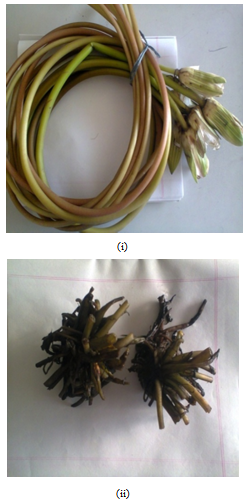 | Figure 2(a). Photographs of Used Water Lilies, (i) Upper Part with Flower (ii) Root |
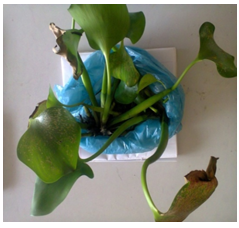 | Figure 2(b). Photographs of Used Water Hyacinth |
 | Figure 2(c). Photographs of Used Bark of Plantain Plant (Banana) |
2.2. Chemicals and Testing Instruments
For Jar Test of coagulation experiments, AR grade coagulants have been used and those were ferrous sulfate (FeSO4), potash alum (K2SO4.Al2(SO4)3.24H2O), ferric chloride (FeCl3) and calcium oxide (CaO).Following pocket-sized meters were used to measure pH and TDS.Specifications of the TDS meter: Pocket Sized TDS Meter, Range: 100 / 1000 ppm, Model: HI 96302, Manufacturing Company: Hanna Instruments, Country of Origin: Italy.Calibration process: The TDS meter has been calibrated by a standard solution (1382 mg/L) as per operation manual of manufacturer.Specifications of the pH meter: Pocket Sized pH Meter, Model: HI 96107, Manufacturing Company: Hanna Instruments, Country of Origin: Italy.Calibration process: The pH meter has been calibrated by three buffer solutions (pH = 7, pH = 4 and pH = 10) as per suggested method in operation manual of manufacturer.
2.3. Experimental Procedure for Treatment of Effluents with Aquatic/non Aquatic Plants
At first the color, odor, TDS and pH values of the collected inlet and outlet effluents were measured.50 mg of each plant was chopped into small pieces and easily immersed into the conical flask or beaker separately.The inlet[Figure 3(a)] and outlet effluents[Figure 3(b)] were taken in three conical flasks and three beakers respectively. Each of the conical flask or beaker contained 300 mL effluent sample.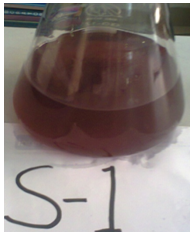 | Figure 3(a). Inlet effluent sample has been used for experiments |
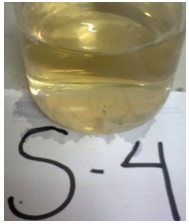 | Figure 3(b). Outlet effluent sample has been used for experiments |
Each of the conical flask and beaker was specified by an individual sample number (S-1 - S-6), after that the chopped plants were immersed in different conical flasks (containing inlet effluents) and beakers (containing outlet effluents) and shaken gently to mix-up with the effluent well. The contents of various samples were as follows.S-1: 300 mL inlet effluent + 50 mg of Water Hyacinth (Eichornia crassipes).S-2: 300 mL inlet effluent + 50 mg of Plantain Plant (Banana) Bark (Musa sapientum)[Figure 4(a)].S-3: 300 mL inlet effluent + 50 mg of Water Lilies (Nymphaea nouchali).S-4: 300 mL outlet effluent + 50 mg of Water Hyacinth (Eichornia crassipes)[Figure 4(b)].S-5: 300 mL outlet effluent + 50 mg of Plantain Plant Bark (Banana Tree Bark) (Musa sapientum)[Figure 4(c)].S-6: 300 mL outlet effluent + 50 mg of Water Lilies (Nymphaea nouchali).These samples were kept in the laboratory for 48 hours at room temperature for adsorption of pollutants on plants. After 48 hours, the samples were observed very carefully to detect the change of color, odor, TDS and pH of the treated effluents.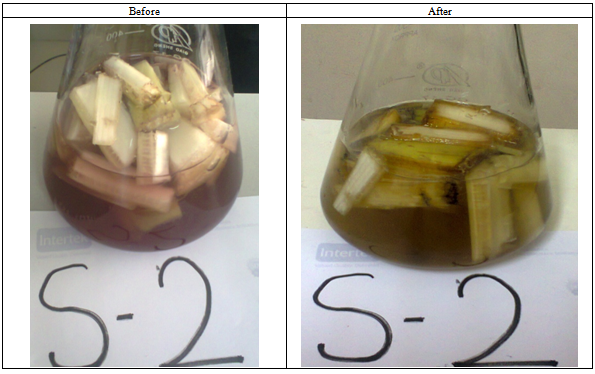 | Figure 4(a). S-2: 300 mL inlet effluent + 50 mg of bark of Plantain plant (Banana) (Musa sapientum) |
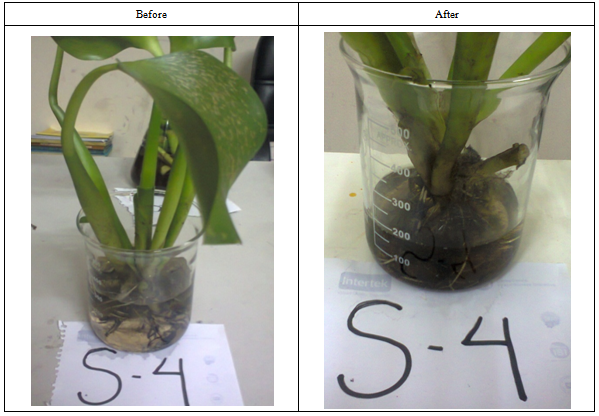 | Figure 4(b). S-4: 300 ml outlet effluent + 50 mg of Water Hyacinth (Eichornia crassipes) |
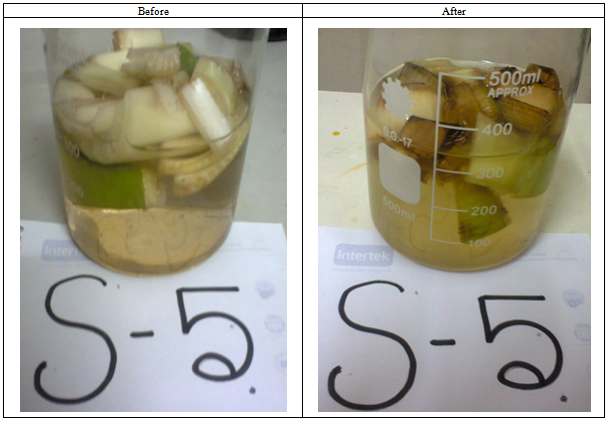 | Figure 4(c). S-5: 300 mL outlet effluent + 50 mg of bark of Plantain Plant (Banana) (Musa sapientum) |
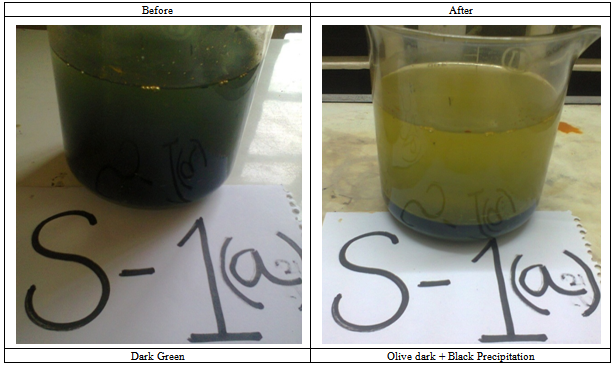 | Figure 5(a). Jar Test with S-1(a): 300 mL inlet effluent + 30 g FeSO4 + 10 g CaO + 100 mL tap water |
2.4. Experimental Procedure with Different Types of Coagulants (Jar Test)
For Jar test seven types of coagulants were prepared for treating the inlet effluent which were collected in different vessels and marked with different sample numbers (S-1(a), S-2(b), S-3(c), S-4(d), S-5(e), S-6(f) and S-7(g)). The contents of the samples are given below.S-1(a): 300 mL inlet effluent + 30 g FeSO4 + 10 g CaO + 100 mL tap water. S-2(b): 300 mL inlet effluent + 30 g K2SO4, Al2(SO4)324H2O + 10 g CaO + 100 mL tap water.S-3(c): 300 mL inlet effluent + 30 g FeCl3 + 10 g CaO + 100mL tap water.S-4(d): 300 mL inlet effluent + (15 g FeSO4 + 15 g K2SO4.Al2(SO4)324H2O) + 10 g CaO + 100 mL tap water.S-5(e): 300 mL inlet effluent + (15 g FeSO4 + 15 g FeCl3) + 10 g CaO + 100 mL tap water.S-6(f): 300 mL inlet effluent + (15 g FeCl3 + 15 g K2SO4.Al2(SO4)3 24H2O) + 10 g CaO + 100 mL tap water.S-7(g): 300 mL inlet effluent + (10 g FeSO4 +10 g K2SO4.Al2(SO4)3 24H2O+10 g FeCl3) + 10 g CaO + 100 mL tap water.The initial observations were recorded just after addition of various coagulants and final observations were recorded after two hours of coagulant addition.
3. Results and Discussion
Water Hyacinth (Eichornia crassipes), Bark of Plantain plant (Banana ) (Musa sapientum) and Water Lily (Nymphaea nouchali) were used for adsorption of dyestuff to remove pH, TDS and colors from Textile effluent of Echotex (BD) Ltd; Chandra, Gazipur.
3.1. TDS Removal from the Inlet Effluent Using Aquatic and Non Aquatic Plants
Water Hyacinth kept the TDS value unchanged, Plantain Plant (Banana) decreased the TDS value by 3.70% and Water Lily also kept the TDS value unchanged (Figure 7).
3.2. TDS Status from the Outlet Effluent Using Aquatic and Non Aquatic Plants
Water Hyacinth increased the TDS by 43.48%, both the Banana and Water Lily showed the values unchanged (Figure 9).Water Hyacinth increased the TDS values due to bio-degradation of the plants. Since the amount of testing effluent was little enough that’s why a little amount of degradation increased the TDS value fair enough. It may not be happened in the ETP where huge amount of Effluent will be treated.Table 5. Initial and Final Physicochemical Parameters of Inlet and Outlet Effluents
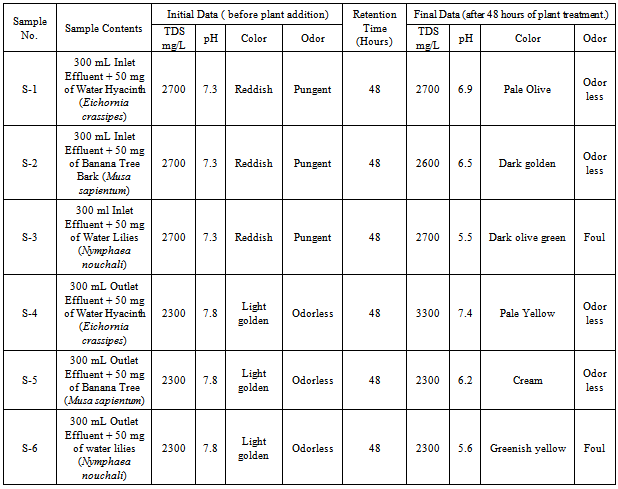 |
| |
|
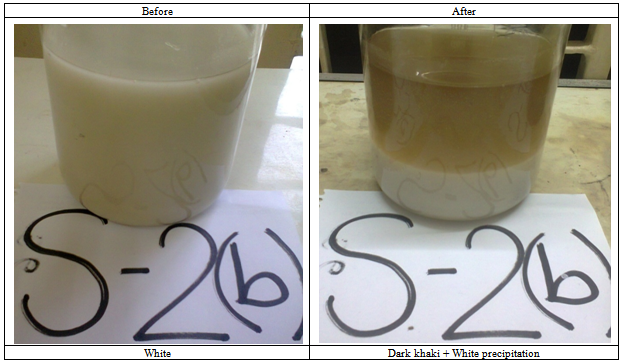 | Figure 5(b). Jar Test with S-2(b): 300 mL inlet effluent + 30 g K2SO4,Al2(SO4)324H2O+ 10 g CaO + 100 mL tap water |
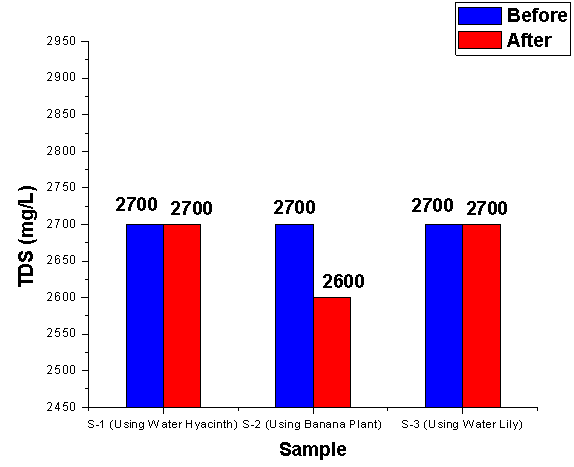 | Figure 6. A column diagram of TDS from the inlet effluent using Water Hyacinth, Plantain Plant (Banana) and Water Lily |
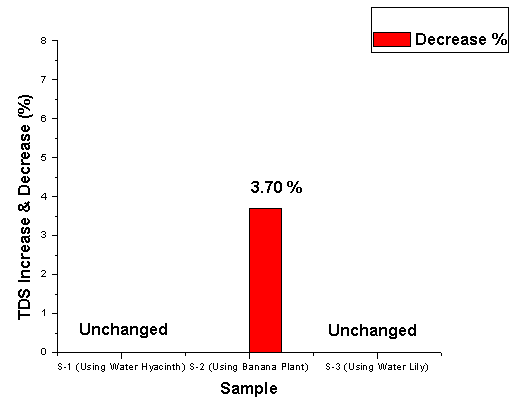 | Figure 7. A column diagram of TDS showing percentages of increase and decrease of the inlet effluent using Water Hyacinth, Plantain Plant (Banana) and Water Lily |
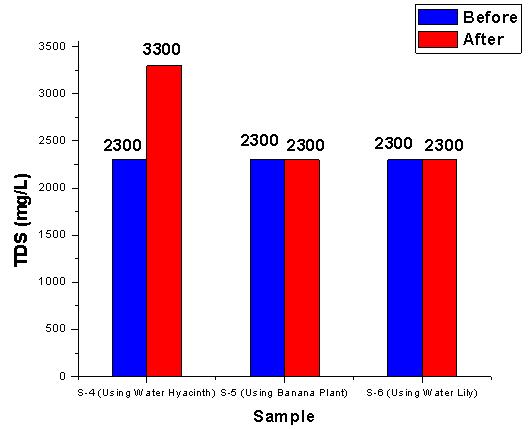 | Figure 8. A column diagram of removal of TDS from the outlet effluent using Water Hyacinth, Plantain Plant (Banana) and Water Lily |
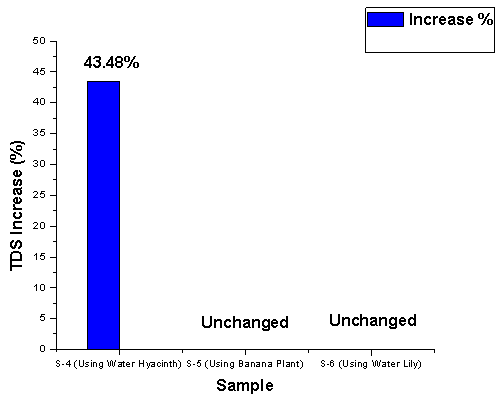 | Figure 9. A column diagram of TDS showing percentages of increase and decrease of the outlet effluent using Water Hyacinth, Plantain Plant (Banana) and Water Lily |
3.3. pH Removal of Inlet Effluent Using Aquatic and Non Aquatic Plants
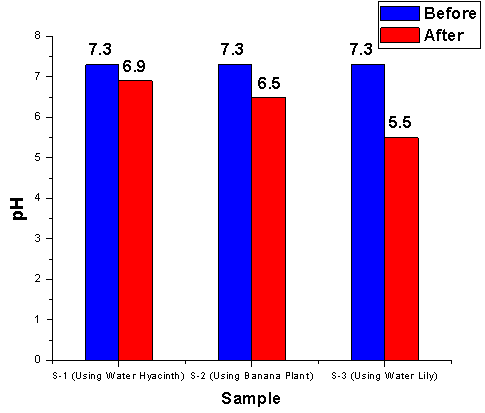 | Figure 10. A column diagram of change in pH of the inlet effluent using Water Hyacinth, Plantain Plant (Banana) and Water Lily |
Water Hyacinth decreased the pH by 5.48%, Plantain Plant (Banana) decreased the pH value by 10.96% and Water Lily decreased the pH value by 24.66%[Figure 11]. | Figure 11. A column diagram of pH showing percentages of increase and decrease of the Inlet Effluent using Water Hyacinth, Plantain Plant (Banana) and Water Lily |
3.4. Change in pH of Outlet Effluent Using Aquatic and Non Aquatic Plants
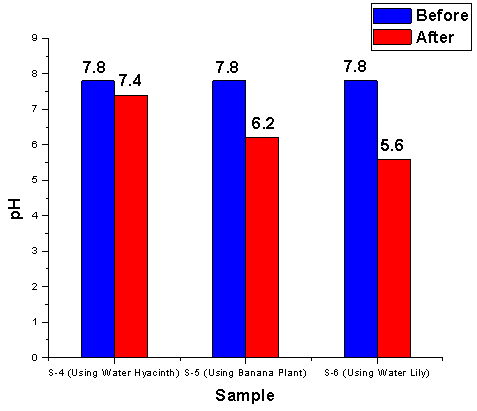 | Figure 12. A column of change in pH of the outlet effluent using Water Hyacinth, bark of Plantain Plant (Banana) and Water Lily |
Water Hyacinth decreased the pH by 5.13%, Plantain Plant (Banana) bark decreased the pH value by 20.51% and Water Lily decreased the pH value by 28.21%[Figure 13].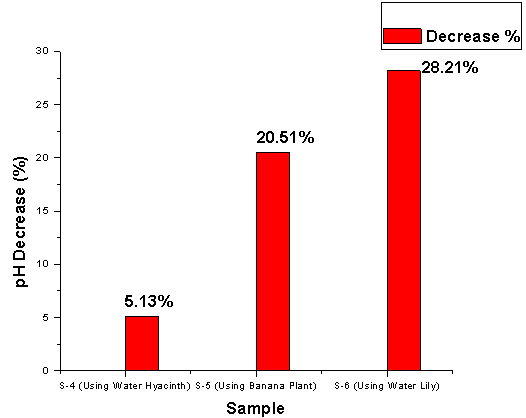 | Figure 13. A column diagram of pH showing percentages of increase and decrease of the outlet effluent using Water Hyacinth, Banana Tree and Water Lily |
Table 6. Physicochemical parameters of the inlet and outlet effluent using different coagulants
 |
| |
|
3.5. Change in pH of the Inlet Effluent Using Different Coagulants
According to experimental results we can conclude that, sample S-1(a) decreased the pH 33.33%, sample S-2(b) kept the pH value unchanged, sample S-3(c) decreased the pH by 20%, sample S-4(d) increased the pH by 20.51%, sample S-5(e) decreased the pH by 26.66%, sample S-6(f) kept the pH value unchanged and sample S-7(g) decreased the pH by 11.11%.
3.6. Change in Color or Dyestuff Removal of the Inlet and Outlet Effluent Using Aquatic and Non Aquatic Plants
In the case of dyestuff removal, the principle was absorption of the dyestuff by the plants and each plant has shown a remarkable result.According to the observation of these experiments, both in inlet and outlet effluents, the ability of changing the color or dyestuff removal (by absorption) the plants can be ranked as follows.Water lily < Water Hyacinth < Plantain Plant Bark (Banana)It indicates banana bark has the best ability to change the color of the Effluent among three plants.It should be noted that, literature survey showed that Eucalyptus bark has been used as adsorbent for removal of reactive dyes[7] from Textile effluent.
3.7. Change in Color or Dyestuff Removal of the Inlet Effluent Using Different Coagulants
Among all of the coagulants, S-4(d): 300mL Inlet Effluent + (30 g FeSO4 + 10g CaO + 100 mL Tap water), has shown the best result of color removal. It changed the inlet effluent color from dark green to olive dark with black precipitation of sludge.
3.8. Management of Poisonous Plants
A question should be raised that, after treating the effluent with the aquatic and non aquatic plants what action should be taken with those plants. Since, the plants get poisonous effect after treating the effluent, those plants could not be dumped here or there.Bio-gas generation by anaerobic digestion of plants could be the best and economic solution. Anaerobic digestion is a series of processes in which microorganisms break down biodegradable material in the absence of oxygen. It is used for industrial or domestic purposes to manage waste and/or to release energy[15].There are four key biological and chemical stages of anaerobic digestion[15]:1. Hydrolysis2. Acidogenesis3. Acetogenesis4. MethanogenesisThe digestion process begins with bacterial hydrolysis of the input materials to break down insoluble organic polymers, such as carbohydrates, and make them available for other bacteria. Acidogenic bacteria then convert the sugars and amino acids into carbon dioxide, hydrogen, ammonia, and organic acids. Acetogenic bacteria then convert these resulting organic acids into acetic acid, along with additional ammonia, hydrogen, and carbon dioxide. Finally, methanogens convert these products to methane and carbon dioxide. The methanogenic archaea populations play an indispensable role in anaerobic wastewater treatments.This biogas can be used directly as cooking fuel, in combined heat and power gas engines or upgraded to natural gas-quality biomethane. The use of biogas as a fuel helps to replace fossil fuels. The nutrient-rich digest ate also produced can be used as fertilizer[15].
4. Conclusions
This paper includes two parts. In part І, method for pH, TDS and color (dye stuff) removal by using aquatic/non aquatic plants has been developed and in part ІІ, different combinations of coagulants treated for achievement of better coagulation.In part I, three plants, water lilies (Nymphaea nouchali)[Figure 2(a)], Water Hyacinth (Eichornia crassipes)[Figure 2(b)], Plantain Plant (Banana) (Musa sapientum)[Figure 2(c)] were treated for adsorption of pollutants resulting removal of pH, TDS and color. For example in case of pH removal from inlet effluent, pH decreased 5.48% by Water Hyacinth, 10.96% by banana plant bark and 24.66% by Water Lily. All of three plants could be useful for adsorption of pollutants from Textile effluent. But considering all experimental results, removal of pH (10.96%), TDS (3.7%) and color, it could be concluded that the treatment of the bark of Plantain Plant (Banana) could be an important method in Textile effluent treatment in Bangladesh and other countries where banana plants are available and easy to cultivate. This method will be low cost compared to other methods. In part II, different types of chemical coagulants used in this work. The best result was achieved in case of a mixture of ferrous sulfate and lime. This coagulant mixture decreased a maximum pH 33.33% among all other coagulant mixtures. The color changed from dark green to olive dark with a black sludge sedimentation.The question remains in the area that how poisoned plants would be managed. The unique solution of this problem will be generation of biogas by using poisoned plants and utilization of biogas in the captive power plant of the concerned industry.
References
| [1] | Mo, J.; Hwang J.-U.; Jegal J. and Kim J. 2007. “Pretreatment of a Dyeing Wastewater Using Chemical Coagulants”, Dyes and Pigments. 72 (2): 240-245. |
| [2] | Kutlu, S.; Solmaz, A.; Birgul, A.; Ustun, G. K. and Yonar, T. 2006. “Colour and COD removal from textile effluent by coagulation and advanced oxidation processes”, Coloration Technology, 122 (2): 102-109. |
| [3] | (a) Mondal, S. and Guha, A. K. 2011. “Characterization of Textile Waste Water of Chittagong and Narayangonj Areas”, Bangladesh Textile Today, issue: Jul-Aug. (b) Guha, A. K. and Hoque, M. I. 2009. “Characterization of Textile waste water of Different Areas of Bangladesh” Bangladesh Textile Today, 2 (3): 16-20. |
| [4] | (a) Roy, R.; Fakhruddin, A. N. M.; Khatun, R,; Islam, M. S.; Ahsan, M. A. and Neger, A. J. M. T. 2010. “Reduction of COD and pH of Textile Industrial Effluents by aquatic Macrophytes and Algae”, Journal of Bangladesh Academy of Sciences, 34 (1): 9-14. (b) Eliassen, R. and Bennet, G.E. 1967. “Anion Exchange and Filtration Techniques for Wastewater Renovation, J. Water pollution Control Fed, , 39: R-82-91. (c) Anjaneyulee, Y.,;Chary, N.S. and Raj, D.S. 2005. “Decolorization of Industrial Effluents Available Methods for Emerging Technologies”, Rev., Environ. Sci, Biotechnology., 4: 245-273. (d) Wu. J.; Doan, H. and Upreti, S. 2008. “Decolorization of Aqueous Textile Reactive Dye by Ozone”, Chem. Eng. J., 142: 156-160. (e) Dieper, D; Corriea, V.M. and Judd, S.J. 1996. “The Use of Membranes for the Recycling of Water and Chemicals From Dye House Effluents: An Economic Assessment”, JSDC, 112: 272-281. (f) Kaushik, P. and Malik, A. 2009. “Microbial Decolorization of Text |
| [5] | Mokhtar, H.; Morad, N.; Fizani, F. and Fizri, A. 2011. “Hyperaccumulation of Copper by Two Species of Aquatic Plants”, International Conference on Environment Science and Engineering; IPCBEE, Vol.8 (2011), IACSIT Press, Singapore. |
| [6] | http://www.ehow.com/about_6625533_do-aquatic-plants-absorb-pollution_.html |
| [7] | Morais, LC., Frietas, O.M., Goncalkes, E.P. andVasconceleas, L.T. , 1999, “Reactive Dye Removal From Wastewater by Adsorption on Eucalyptus Bark, Variables that Define the Process”, Water Research, 33: 979-988. |
| [8] | http://www.gardenguides.com/79534-advantages-water-lilies.html |
| [9] | http://en.wikipedia.org/wiki/Banana |
| [10] | Annadurai, G.; Juang, R.S. and Lee, D.J. 2002. “Use of Cellulose Based Wastes for Adsorption of Dyes from Aqueous Solution”, J. Hazardous Materials, 92(3): 263-274. |
| [11] | http://en.wikipedia.org/wiki/Total_dissolved_solids |
| [12] | Akhtaruzzaman, M.; Clemett, A.; Knapp, J.; Mahmood, M. A. and Samiya, A. “Choosing an Effluent Treatment Plant”, ISBN: 984 - 8121 - 07 – 2. |
| [13] | “Guide for Assessment of Effluent Treatment Plants”, Department of Environment, Ministry of Environment and Forest, Bangladesh ; June, 2008. |
| [14] | Jamaluddin, A. M. and Nizamuddin, M. 2012.“Physicochemical Assessment of Textile Effluents in Chittagong Region of Bangladesh and Their Possible Effects on Environment”, International Journal of Research in Chemistry and Environment ;2(3): 220-230. |
| [15] | http://en.wikipedia.org/wiki/Anaerobic_digestion |




















 Abstract
Abstract Reference
Reference Full-Text PDF
Full-Text PDF Full-text HTML
Full-text HTML




